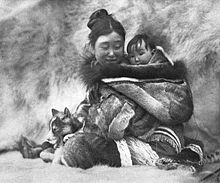High Arctic relocation
[2][3] The forced migration is widely considered to have been implemented by the Canadian government to assert its sovereignty in the Arctic Archipelago (which has been subject to disputed territorial claims) by the use of "human flagpoles".
[8] They were joined by three families recruited from the more northern community of Pond Inlet (in the then Northwest Territories, now part of Nunavut) whose purpose was to teach the Inukjuak Inuit skills for survival in the High Arctic.
[3][8][10] The families were left without sufficient supplies of food and caribou skins and other materials for making appropriate clothing and tents, and suffered extreme privation in the first years after the relocation.
[9] Despite this, Royal Canadian Mounted Police (RCMP) reports from the time stated that the two colonies were generally successful in terms of morale, housing, and subsistence living.
[10] As they had been moved about 2,000 km (1,200 mi) to a very different ecosystem, the displaced people were unfamiliar with the wildlife and had to adjust to months of polar night (24-hour darkness) during the winter, and the midnight sun (24-hour sunlight) during the summer, something that does not occur in northern Quebec.
[3][8] In 1990, the Canadian House of Commons Standing Committee on Aboriginal Affairs asked the government to apologize to the Inuit who had been moved to the high Arctic in 1953, to provide compensation to them, and to formally recognize the residents of Resolute and Grise Fiord for their service to Canada's sovereignty.
[5][15] In response, the government commissioned the "Hickling Report", which absolved them of wrongdoing, arguing that the Inuit had volunteered to be moved, and that they had been relocated due to the harsh social and economic conditions in Inukjuak.
[3] The Commission found that the government of Canada had determined to "rehabilitate" the Inuit of Port Harrison, weaning them from dependency and "moral decline" by moving them to better lands with abundant game for hunting, and that inadequate preparations were made for them.
The federal government refused to apologize, but established a "Reconciliation Agreement" in March 1996, creating a $10 million CAD trust fund for relocated individuals and their families.
John Duncan (Minister of Indian Affairs and Northern Development) stated: The Government of Canada deeply regrets the mistakes and broken promises of this dark chapter of our history and apologizes for the High Arctic relocation having taken place.
We would like to pay tribute to the relocatees for their perseverance and courage...The relocation of Inuit families to the High Arctic is a tragic chapter in Canada's history that we should not forget, but that we must acknowledge, learn from and teach our children.
[4] Carvers Looty Pijamini (of Grise Fiord) and the late Simeonie Amagoalik (of Resolute) were commissioned by Nunavut Tunngavik Incorporated to build a monument to commemorate the Inuit who sacrificed so much as a result of the Government relocation of 1953 and 1955.




